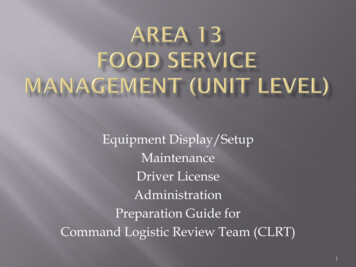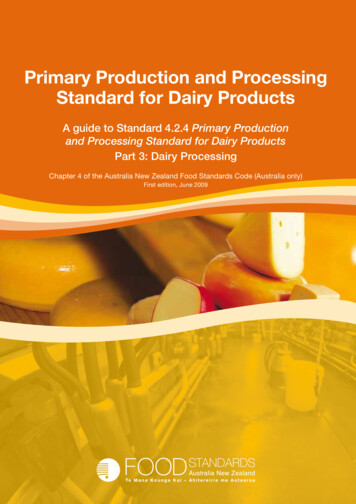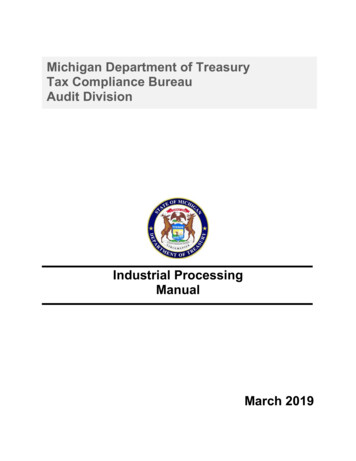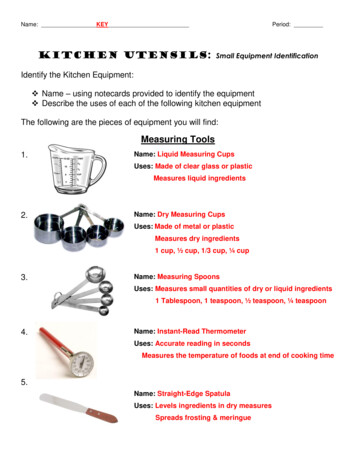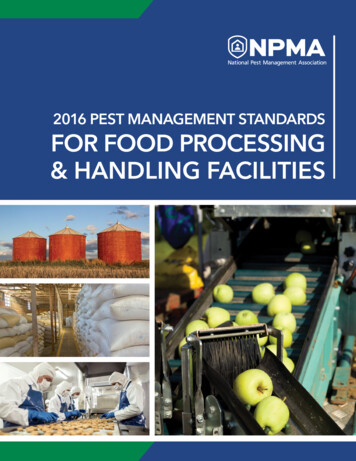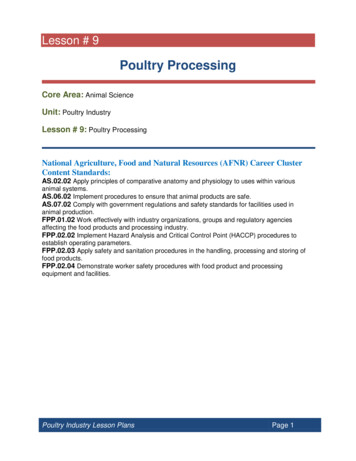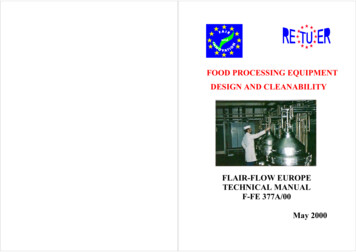
Transcription
FOOD PROCESSING EQUIPMENTDESIGN AND CLEANABILITYFLAIR-FLOW EUROPETECHNICAL MANUALF-FE 377A/00May 2000
FOOD PROCESSING EQUIPMENTDESIGN AND CLEANABILITYThis technical manual is one of five in the(ready-to-use Europeanresearch) series produced by the FLAIR-FLOW EUROPE dissemination project. Thisproject is funded under the EU FAIR and INNOVATION Programmes (contracts CT-973014 and INAMI 0520 respectively).F-FE 377A/00 [May 2000]This technical manual was prepared for FLAIR-FLOWEUROPE by:John HolahCampden and Chorleywood Food Research Association(CCFRA)Chipping CampdenGlos GL55 6LDUnited KingdomFor more information on the FLAIR-FLOW EUROPE disseminationsystem contact Ronan Gormley at Teagasc, The National FoodCentre, Dunsinea, Castleknock, Dublin 15, Ireland.Telephone: 353-1-8059500; Fax: 353-1-8059550;E-mail: r.gormley@nfc.teagasc.ieor visit website http://www.exp.ie/flair.html2000 TeagascThe National Food CentreDunsinea, CastleknockDublin 15, IrelandISBN1 84170 107 6TITLEFood Processing Equipment Design and CleanabilityNo responsibility is assumed by the publisher for any injury and/or damage to persons orproperty as a matter of product liability, negligence or otherwise, or from any use oroperation of any methods, products, instructions or ideas contained in the materialsherein.Neither the European Commission nor any person acting on behalf of the Commission isresponsible for the use which might be made of the information contained in this volume.Mention of any brand or firm names does not constitute an endorsement over others of asimilar nature not mentioned.
PREFACEThe acronym ‘’ was coined by the FLAIR-FLOW dissemination team todenote ‘ready-to-use European research’ and resulted in a series ofworkshops across Europe. Theworkshops are aimed at food SMEs, andespecially at the small and very small companies. The goal is to bring results from EUsupported food research projects to food SMEs Europe-wide, in an easily understoodform, thereby facilitating application and use of the results both in the short and longterm. Each workshop carries a series of handouts and these have been collated into fivetechnical manuals with the following titles:1.2.3.4.5.Ready-to-use fruit and vegetables[ISBN 1 84170 106 8]Food processing equipment design and cleanability[ISBN 1 84170 107 6]Managing the cold chain for quality and safety[ISBN 1 84170 108 4]Microbial control in the meat industry[ISBN 1 84170 109 2]Freshness, quality and safety in seafoods[ISBN 1 84170 110 6]Ronan GormleyProject Leader, FLAIR-FLOW EUROPETeagasc, The National Food CentreDunsinea, CastleknockDublin 15, IrelandTel: 353-1-8059500Fax: 353-1-8059550E-mail: r.gormley@nfc.teagasc.ieCONTENTSPage Basics of hygienic design and cleanability offood production equipment.6Defining the purpose for which the chosen equipmentwill be used9 Controlling/eliminating risks through hygienic design10 Does the equipment need to meet any legalrequirements/required hygienic design standards?11 Does the equipment meet requirements, and is cleanable? Guidance on the installation of equipment22 Cleaning/disinfecting to ensure hygienic status23 Training needs in hygienic design29 Obtaining further information References32 Bibliography34 Annexe 1: EU Project Partnership36 Acknowledgements37 Figures 1 to 101530385
Why should I be concerned with the hygienic design and cleanabilityof food production equipment?The schematic diagram below shows that the production of safe,wholesome foods, the major concern of the food industry, stems from athorough risk assessment. Indeed this is now a legal requirement. Thediagram also shows that given specified raw materials, there are fourmajor ‘building blocks’ that govern the way the factory is operated toensure that the safe, wholesome food goal is realised.HACCPOf the four building blocks illustrated in the schematic diagram, thispresentation deals with hygienic design. and hygienic practices. Alongwith these two blocks, the design of a suitable process to kill or controlrelevant microorganisms, together with a suitable process control system(usually involving a quality system e.g. ISO9000 and HACCP) areequally important.Hygienic design is concerned with: factory siting and constructionSpecified rawmaterialsHygienic designA hazard analysis should be undertaken at the earliest opportunity in theprocess of food production and if possible, before the design andconstruction of the processing facility. design of the building structureProcess development selection of surface finishes segregation of work areas to control hazardsHygienic practicesProcess control flow of raw materials and product movement and control of peopleSafe, wholesomefoodRisk assessment encompasses identifying the hazards that may affect thequality or safety of the food product and controlling them at all stages ofthe process such that their risk to product contamination is minimised. Inthe food industry this is commonly referred to as Hazard Analysis CriticalControl Point (HACCP).Such hazards are usually described as; Biological, e.g. bacteria, yeasts, moulds Chemical. e.g. cleaning chemicals, lubricating fluids Physical, e.g. glass, insects, pests, metal, dust6 design and installation of the process equipment design and installation of services (air, water, steam, electrics etc.).Hygienic practices are concerned with: processes that return the processing environment to its originalcondition. These are usually referred to as cleaning and disinfectionor sanitation programmes. practices that keep the building and equipment in efficient operation.These are referred to as the maintenance programme. practices that relate to the control of cross-contamination duringmanufacture, usually related to people, surfaces, the air and the7
segregation of raw and cooked product. Such control is generallyreferred to as Good Manufacturing Practice (GMP)This technical manual is concerned with the hygienic design of foodprocessing equipment and their sanitation programmes. Hygienic design and practices are thus two of the key factors inproducing safe and wholesome foodsFood processing equipment that is designed hygienically has three keyadvantages: Food qualityGood hygienic design maintains product in the main product flow. Thisensures that product is not 'held-up' within the equipment where it coulddeteriorate and affect product quality on rejoining the main product flow.Or, for example in flavourings manufacture, one batch could not crosscontaminate a subsequent batch to give sensory problems. Food safetyGood hygienic design prevents the contamination of the product withsubstances that would adversely affect the health of the consumer. Suchcontamination could be microbiological (e.g. pathogens), chemical (e.g.lubricating fluids, cleaning chemicals) and physical (e.g. glass). Cost reductionGood hygienic design reduces the time required for an item of equipmentto be cleaned. This reduction of cleaning time is significant over thelifetime of the equipment such that hygienically designed equipmentwhich may initially be more expensive (compared to similarly performingpoorly designed equipment), will be more cost effective in the long term.In addition, reduced down time for cleaning may lead to the opportunityfor increased production.Of these three factors, safety is the most important to the food consumer.There have been many examples of product recalls, lost production, andindeed site closure, due to contamination arising from poorly designedequipment. Physical foreign body contaminants, such as pieces ofplastic, affect the wholesomeness of food but rarely receive mediaattention. Physical contaminants of a more serious nature e.g. glass8fragments or caustic CIP fluids, however, are much more serious.Perhaps of the most concern are pathogenic microorganisms such asListeria or Escherichia coli O157:H7, which may be harboured inequipment and then subsequently grow during production andcontaminate the product.How do I define the purpose for which the chosen equipment will beused?Food processing equipment has traditionally been designed and built tobe suitable for purpose. For example, a mixer for raw meat has rarelybeen designed to the same hygienic level as a slicer of cooked meats.Similarly, aseptic fillers have usually been designed to a much higherhygiene standard than can filling machines. The reason for this has beenrelated to the risk of a hazard being transferred from the equipment to theproduct produced and thus the consumer.The degree of risk from eating foodstuffs is dependent to a large extenton how that product has been processed, its degree of preservation andwhat further cooking steps (if any) the consumer has to perform prior toconsumption. For example, a stable preserved product e.g. canned ordried goods, or one which requires thorough cooking prior toconsumption, is less likely to confer a microbiological risk than a readyto-eat chilled food. All of the above food products may, however, conveysimilar risks in terms of non microbiological hazards, i.e. physicalhazards (e.g. glass, plastic) or chemical hazards (e.g. lubricating fluids,cleaning chemicals, pesticides). Both the designer and the user of the equipment have aresponsibility to assess the risks to the product consumer arisingfrom any hazards within the equipment.The designer and manufacturer of the equipment needs to: identify the process for which the machine is intended, identify the relevant hazards associated with the products produced, design methods/measures which can eliminate hazards or reduce theirrisk,9
identify any other hazards introduced by the methods used to reducethe hazard under analysis, verify the effectiveness of the hazard elimination or risk reduction, describe any residual risks and any additional precautions necessaryfor the machine's safe use.To help equipment manufacturers meet this challenge, and thus bothcontrol the risk of transfer of a hazard to a food product duringmanufacture and produce the equipment in a cost effective manner, foodmanufacturers should enter a dialogue with equipment manufacturers toconsider the following: The intended use of the equipment. Will the equipment be used forone specific purpose only, for which the hazards are readilyidentifiable, or could the machine be used for a wide range of productsin many industries (e.g. a pump)? The product type to be processed. Will the product be alreadycontaminated (e.g. a raw material) or will it be 'preserved' or 'aseptic'? The degree of further product processing: Will the product processedby the equipment subsequently undergo a further process whichfunctions as a hazard elimination step (e.g. a heat treatment) or is theprocess for which the machine is intended the final process? The degree of cleaning and/or inspection. Is the equipment to becleaned and/or inspected after every use, routinely during the day,every day or every week etc.? The use of the machine. Is the equipment likely to be well maintainedor used infrequently, is it designed for high or continuous use or is itliable to abuse?What level of hygienic design should I be looking for to control oreliminate these risks?After a risk assessment has been made, it is possible to assign thesuitability of an item of equipment to one of three basic categories forintended use. These can be described as:101. equipment that satisfies the minimum requirements to make it safe forits intended purpose. This may involve the control of single hazards,e.g. the equipment contains no glass.2. equipment that satisfies all the current best practice hygienic designcriteria and is thus fit for the production of most foods, though it needsto be dismantled prior to cleaning.3. equipment that satisfies all the current best practice hygienic designcriteria and can be cleaned without dismantling.4. equipment that satisfies all the current best practice hygienic designcriteria and is designed for a specific heat or chemicaldecontamination treatment.5. equipment that satisfies all the current best practice hygienic designcriteria, is also designed for a specific heat or chemicaldecontamination treatment and will prevent ingress ofmicroorganisms. Such equipment would be suitable, for example, forthe the production of aseptic foods.Whilst it is acceptable (though not necessarily cost effective) to useequipment designed for a higher hygienic requirement for a lower riskproduct, it is unlikely to be acceptable to use equipment designed for alower risk category of food products for higher risk or aseptic products.Does the equipment need to meet any legal requirements or is thereany guidance on required hygienic design standards?There are relatively few international hygienic equipment designstandards and these are predominantly dairy based concerning pipelinesand vessels (Anon 1973, 1974, 1976, 1980, 1983a, 1983b).In the EC, the Council Directive on the approximation of the laws ofMember States relating to machinery (89/392/EEC) was published on the14th June 1989 and was subsequently updated by 98/37/EC. TheDirective includes a short section dealing with hygiene and designrequirements which states that machinery intended for the preparationand processing of foods must be designed and constructed so as to avoidhealth risks and consists of seven hygiene rules that must be observed.These rules are concerned with the suitability and cleanability ofmaterials in contact with food; surface finish and design features such asjoints, absence of ridges and crevices; avoidance of the use of fasteners,11
e.g. screws and rivets; the design of internal angles and corners; drainageof residues from equipment surfaces; dead spaces and voids, and lastlybearings and shaft seals. The Directive requires that all machinery soldwithin the EC after January 1995 shall meet these basic standards and bemarked accordingly to show compliance (the 'CE' mark). All food processing equipment sold in the EU must show the 'CE'mark and comply with the safety and hygiene aspects of 98/37/ECIn addition to these hygiene rules, Section 2.1 contains a requirement thatmachinery manufacturers must indicate the recommended products(chemicals) and methods for cleaning, disinfecting and rinsing both openequipment (e.g. a conveyor) and closed equipment (e.g. pipelines, valvesand pumps) where clean-in-place (CIP) procedures need to be used.The Commission turned to the European Standards Organisation (CEN)to produce standards as one means of interpreting this Directive andTechnical Committee CEN/TC 153 is concerned with the hygienespecifications of food processing machinery. A European “C” levelStandard EN 1672-2 "Food processing machinery-Safety and hygienerequirements-Basic concepts-Part 2; Hygiene requirements" has recentlybeen adopted. In addition to this, a number of Working Groups ofCEN/TC 153 are producing specific standards on bakery, meat, catering,edible oils, vending and dispensing, pasta, bulk milk coolers, cerealprocessing and dairy equipment.It is impossible to provide hygienic design guidelines for all individualfood processing equipment. The approach of the CEN/TC 153 was,therefore, to define the basic hygienic design requirements and these canbe presented under two headings, Food contact (broken down into elevensubsections) and Non-food contact areas. These are described andinterpreted below. Illustrative figures have been taken from CCFRAtexts.Stainless steel usually meets all these requirements and there are variousgrades of stainless steel which are selected for their particular propertiesto meet operational requirements, e.g. Type 316 which containsmolybdenum is used where improved corrosion resistance is necessary.Elastomers and other polymers should retain their surface andconformational characteristics when exposed to the conditionsencountered in production, cleaning and decontamination. Surface finishProduct contact surfaces must be finished to a degree of surfaceroughness that is smooth enough to enable them to be easily cleaned anddisinfected. For closed equipment (that used for liquid handling andusually cleaned-in-place CIP) a surface finish of 0.8µmRa isrecommended, with higher Ra values being acceptable if they can beshown to be cleanable (see Verification section).Surfaces willdeteriorate with age and wear (abrasion) such that cleaning will becomemore difficult (Holah and Thorpe 1990). JointsPermanent joints, such as those that are welded or bonded, should besmooth and continuous and free from resses, gaps or crevices.Dismountable joints, such as screwed pipe couplings (Figure 1) must becrevice-free and provide a smooth continuous surface on the product side[Note: Figures 1 to 10 are given on pages 38 to 47 for convenience].Flanged joints (Figure 2) must be located with each other and be sealedwith a gasket because, although metal/metal joints can be made leaktight, they may still permit the ingress of microorganisms. FastenersExposed screw threads, nuts, bolts, screws and rivets (Figure 3) must beavoided wherever possible in product contact areas. When unavoidablefor technical reasons, alternative methods of fastening can be used(Figure 4) where the washer used has a rubber compressible insert toform a bacteria-tight seal. Food contact area Materials of constructionMaterials used for product contact must have adequate strength over awide temperature range, a reasonable life; be non-toxic, non-tainting,non-absorbent; be resistant to cracking, chipping, flaking corrosion andabrasion, prevent penetration of unwanted matter under intended use andbe easily cleaned and capable of being shaped.12 Drainage13
All pipelines and equipment surfaces should be self draining becauseresidual liquids can lead to microbial growth or, in the case of cleaningfluids, result in contamination of product (Figure 5). Care should beundertaken with the installation of equipment such that its drainability isnot impaired. Internal angles and cornersThese should be well radiused, wherever possible, to facilitate cleaning(Figure 6).should be sloped to an outside edge and should be easily removed tofacilitate cleaning. ControlsControls, particularly those that are repeatedly touched by food handlersto allow process operation, should be designed to prevent the ingress ofcontamination and should be easily cleanable (Figure 9). Pathogenicmicroorganisms have been known to harbour in switches and betransferred to product every time they are operated. Non-food contact area Dead spacesAs well as ensuring that there are no dead spaces in the design ofequipment, care must be taken that they are not introduced duringinstallation. If dead spaces are unavoidable for technical reasons, theyshould be readily accessible for draining/cleaning as necessary. Bearings and shaft sealsBearings should, wherever possible, be mounted outside the product areato avoid possible contamination of product by lubricants, unless they areedible, or possible failure of the bearings due to the ingress of the product(Figure 7). Shaft seals must be of such design so as to be easily cleanedand if not product lubricated, then the lubricant must be edible. Where abearing is within the product area, such as a foot bearing for an agitatorshaft in a vessel, it is important that there is a groove completely throughthe bore of the bush, from top to bottom to permit the passage of cleaningfluid.Equipment should be designed and constructed to prevent the retention ofmoisture, ingress and harbourage of pests and accumulation of soils. Thedesign should facilitate inspection, servicing, maintenance, cleaning andwhere necessary, disinfection.Surfaces should be made of corrosion resistant materials or should betreated (coated or painted) so as to be corrosion resistant. Equipmentsupports should be designed such that no water or soil can remain on orwithin their structure. Insulation materials should be properly mountedand sealed to prevent the ingress of contamination.How do I know that the equipment meets my requirements and iscleanable?The hygienic design of food processing equipment may need to beverified for a number of reasons. These include During equipment development, e.g. to examine a new configurationor concept. InstrumentationInstruments must be constructed from appropriate materials and if theycontain a transmitting fluid, such as in a bourdon tube pressure gauge,then the fluid must be approved for food contact. Many instrumentsthemselves are hygienic but often they are installed unhygienically(Figure 8). Doors, covers and panels After design, to demonstrate compliance with relevant legislation e.g.98/37/EC. As a quality assurance technique during equipment manufacture. As part of a 'sign-off' procedure after installation at a customer’s site. As part of the normal selection procedure by the customer.Doors, covers and panels should be designed so that they prevent theentry of and/or prevent the accumulation of soil. Where appropriate they1415
Verification methods at a simple level involve the examination of 2 or 3dimensional drawings of the equipment, an examination of the equipmentitself (including dismantling), and verification of the suitability of surfacematerial. In Europe, for many pieces of open processing equipment thiswould probably be the limit of verification required to comply with98/37/EC and thus enable attachment of a 'CE' mark. For more complexequipment, particularly closed processing equipment, however,cleanability tests may be necessary.An EU Fourth Framework funded programme 'Test method developmentfor the practical assessment of food processing equipment cleanability'(Contract Number AIR 1-CT92-0091) was undertaken by the participantsshown in Annex 1 between January 1993 and March 1996. The aim ofthis project was to develop test protocols, on a practical basis, to assess thecleanability of equipment intended for food production.Initial work within the programme concentrated on developing testconditions of materials, microorganism and organic soils, soil applicationmethods and cleaning protocols that could be standardised amongst theparticipants. Stainless steel AISI 316 L was selected as the material onwhich to develop and compare methods. In later trials, comparative workwas undertaken on silicone, two conveyor belt materials (2M 2964 FDAand 2M 1333 FDA) and Polysulfon. The following microorganisms werechosen for trial work as they were known to attach well to surfaces, couldbe detected after cleaning trials and were relatively safe for controlledaerosol dispersal during spray cleaning; Pseudomonas fragi ATCC 4973,Photobacterium leiognathi ATCC 33469, Bacillus thuringiensis ATCC10792 and Bacillus stearothermophilus NIZO C953. Three organic soilswere subsequently chosen for comparative studies as they were shown to bereadily made, stable, easy to apply and relatively detectable after cleaning;'Campden' soil, a mixture of milk, starch and oil; a margarine based soil foruse in the assessment of moderately sized closed equipment; and a souredmilk based soil for use in the EHEDG Cleanability Test Method (seeBiliography, Document 2) for small sized closed equipmentInitial work demonstrated that it was possible to cover small open testobjects by spraying microbial and organic soils with hand held commercialcompressed air driven sprayers. Uniformity of spraying was increased bythe use of a repeat coating, if possible in a different spray direction, and asecond spray of nutrient medium for microbial soils helped preventviability loss on the surface. Soiling of larger size open test items by thesemethods may be difficult and, at best, time consuming. For equipment oflarge size it may be appropriate to first identify areas that could bepotentially difficult to clean and soil and assess these areas only. For16instance, it is unlikely that flat easily accessible surfaces would be difficultto clean but fastenings, corners and areas of poor drainage could well be.Closed equipment of all sizes was easily and consistently soiled bycirculation of the organic and microbial soils. A cleaning protocolconsisting of detergent foaming for 20 min followed by spraying withpotable water at 250 psi for 5 sec with the spray lance approximately 20 cmfrom the surface at an angle of 90o was established as being suitable foropen surfaces. Cleaning protocols for closed surfaces were engineered toprovide a fixed flowrate (1.5 m/s) and variable detergent concentrations,temperature and contact times to allow some residual retention of soils asrequired for comparative analysis. Typically, cleaning of closed surfaceswas based on a three stage process; a rinse with cold water (10-15 C) for 1min followed by circulation of a 1.0% (w/v) mild detergent solution (LeverIndustrial PD332) for 10 min at 63oC with a final rinse with cold water (10- 15 C) for 1 min.Once conditions had been standardised, development of techniques todetect soil residues after cleaning, could be undertaken. Techniquesassessed included an apparatus designed to remove microorganisms fromsurfaces using ultrasound, traditional microbiological swabbing and ATPhygiene testing systems, Direct Epiflurorescent Microscopy (DEM) andvisual and image analysis measurements of stains remaining after cleaning.After a period of development, however, Participants in the programmeagreed that five techniques were the most promising in terms of detectingresidues after cleaning, and that further work should concentrate on therepeatability and reproducibility of these methods. These were:a)Application of P. fragi to open surfaces by spraying, with detectionby TVC, ATP or DEM/DEFT as appropriate.Overnight cultures of P. fragi were resuspended in phosphate buffer andsprayed onto test surfaces using a small compressed air based sprayer(Merck) with spraying in a zig zag pattern to give even coverage. Thesurfaces or equipment were allowed to dry for 15 min and then sprayedwith growth media (0.1% bacteriological peptone, 0.07% yeast extract)prior to cleaning. After cleaning, surfaces were swabbed and the swabsprocessed traditionally or the swab resuspension fluid was assessed byDEFT.b)Application of B. thuringiensis to open surfaces by spraying andclosed surfaces by circulation, with detection by TTC agar overlay.17
Spores of B. thuringiensis were suspended in saline and sprayed ontosurfaces by spraying with sweeping movements using a compressed air'artist's brush' type paint sprayer or by filling the item of equipment with thespore suspension. Immediately after cleaning, surfaces were covered withmolten nutrient agar containing 2,3,5-triphenyltetrazoliumchloride (TTC).The agar was incubated with the surface for a variable time period (up to 5h) at 30oC and the agar was removed from the surface and incubatedovernight. TTC salts, which are water soluble in the oxidized state arereduced to water insoluble formazans by cellular respiration. Whengrowing using this TTC solid medium, colonies appeared red and small,offering an easier visualisation of the contaminated areas.c)The EHEDG small closed equipment test using B.stearothermophilus in a milk soil applied by circulation withdetection by agar overlayThis method was based on 'A method for the assessment of in-placecleanability of food processing equipment', EHEDG Document No. 2. Inthis method, the test item was filled with soured milk containing spores ofB. stearothermophilus, pressurised to 5 bar, drained and dried. The test itemwas then cleaned, drained and dismantled in the laboratory. Test items werecovered in agar as appropriate such that all product contact surfaces werewetted and incubated at 58oC. Spores remaining on the test item aftercleaning may germinate and ferment the glucose in the agar to acidic endpoints. A pH sensitive dye in the agar recorded this fermentation with achange from purple to yellow such that yellow areas indicated microbialgrowth and thus spore presence.d)Application of a margarine soil to closed equipment with visualdetection of β-carotene residues.The test item was filled with a commercially available soft margarine,containing 80% fat with a viscosity of less than 60mPA.s at roomtemperature, and pressurised to 5 bar. After cleaning, the test section wasremoved from the test rig and the test item dismantled. All product contactsurfaces of the test item were examined for the presence of residual soil byvisual inspection and by swabbing the surface with a cotton wool tippedswab. The relative amount of residual soil was recorded on a relativenumber (RN) scale from 0-4 were 0 represented no visible yellow soil and4 indicated soil being highly visible.Tests (c) and (d) were used to interpret cleanability in two ways. Firstly, areference pipe of known surface roughness was assembled together with thetest item to allow a cleanability comparison. Three results for the test item18were possible - more cleanable, less cleanable and the same cleanability.Secondly, information could be recorded as to the precise location of anyyellow area recorded. If, after several tests, yellow was recorded in thesame area on each occasion, this was interpreted as a particularly difficultto clean, or unhygienic, area of the test item.e)Application of a starch, milk and oil (Campden) soil to open surfacesby spraying and closed surfaces by circulation with detection viacalcium residues.A soil was prepared containing 'Coldflo' modified starch, whole milkpowder and vegetable oil and was 'spiked with calcium carbonate (finalconcentration 1.25M) and diluted 1:2 for spraying to excess onto equipmentsurfaces using a Merck TLC sprayer. After cleaning, surfaces wereswabbed by sponges which were resuspended in nitric acid. Dilutedsamples were aspirated into a Perkin Elmer 3300 atomic absorptionspectrophotometer using an air/acetylene flame at 422.7 nm and resultswere calculated as mg calcium/cm2.The selected techniques were further developed and ex
selection of surface finishes segregation of work areas to control hazards flow of raw materials and product movement and control of people design and installation of the process equipment design and installation of services (air, water, steam,



